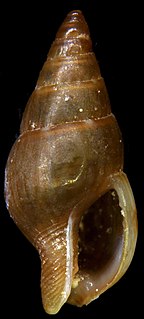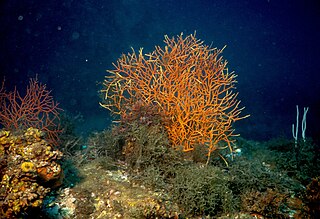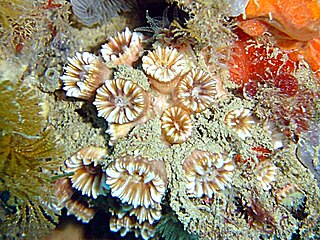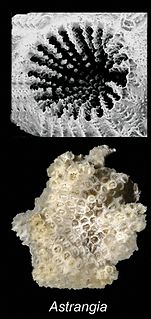
Acropora is a genus of small polyp stony coral in the phylum Cnidaria. Some of its species are known as table coral, elkhorn coral, and staghorn coral. Over 149 species are described. Acropora species are some of the major reef corals responsible for building the immense calcium carbonate substructure that supports the thin living skin of a reef.

Corallimorpharia is an order of marine cnidarians closely related to stony or reef building corals (Scleractinia). They occur in both temperate and tropical climates, although they are mostly tropical. Temperate forms tend to be very robust, with wide and long columns, whereas tropical forms tend to have very short columns with a wide oral disc and very short tentacles. The tentacles are usually arranged in rows radiating from the mouth. Many species occur together in large groups, although there are recorded instances of individuals. In many respects, they resemble the stony corals, except for the absence of a stony skeleton. Morphological and molecular evidence suggests that they are very closely related to stony corals.

Gymnobela is a genus of sea snails, marine gastropod mollusks in the family Raphitomidae.

Bela is a genus of sea snails; marine gastropod mollusks in the family Mangeliidae.

Astyris is a genus of sea snails, marine gastropod mollusks in the family Columbellidae, the dove snails.

Seguenzia is a genus of sea snails, marine gastropod mollusks in the family Seguenziidae.

Cerithiella is a genus of minute sea snails, marine gastropod molluscs in the family Newtoniellidae.

Favia is a genus of reef-building stony corals in the family Mussidae. Members of the genus are massive or thickly encrusting colonial corals, either dome-shaped or flat, and a few are foliaceous. There is a great diversity of form even among individuals of the same species. The corallites project slightly above the surface of the coral and each has its own wall. In most species, the corallites are plocoid and in some, monocentric. The septa and costae linked to the corallite wall are well developed and covered by fine teeth. The polyps only extend and feed during the night. Each one has a small number of tapering tentacles which often have a darker coloured tip; these are called stinger tentacles, or sweeper tentacles. They use these to sweep the water to see if any other coral is in its area; if so, then they begin to sting the other coral. This is commonly known as coral war. Each coral is trying to make sure it has enough room around it so it can continue to grow and have more surface area for its offspring. The columella is parietal and spongy, and there are vesicles on both the endotheca and exotheca. Members of this genus are widespread in both the Atlantic Ocean and the Indo-Pacific.

Gersemia is a genus of soft corals in the family Nephtheidae. Species in this genus are found in cold temperate and polar seas at depths ranging from 20 metres (66 ft) to over 2,000 metres (6,600 ft). The type species is Gersemia loricata.

Leptogorgia is a genus of soft coral in the family Gorgoniidae. The genus has a widespread distribution with members being found in the eastern Atlantic Ocean from Western Europe to South Africa, the Mediterranean Sea, the Atlantic coasts of North and South America, the Antilles and the Pacific coast of America. Species are found in both shallow and deep waters.

Balanophyllia is a genus of solitary corals in the order of stony corals.

Polycyathus is a genus of small corals in the order Scleractinia, the stony corals. Most species occur in the Pacific Ocean.

Anthomastus is a genus of soft corals in the family Alcyoniidae.

Astrangia poculata, the northern star coral or northern cup coral, is a species of non-reefbuilding stony coral in the family Rhizangiidae. It is native to shallow water in the western Atlantic Ocean and the Caribbean Sea. It is also found on the western coast of Africa. The International Union for Conservation of Nature lists this coral as being of "least concern". Astrangia poculata is an emerging model organism for corals because it harbors a facultative photosymbiosis, is a calcifying coral, and has a large geographic range. Research on this emerging model system is showcased annually by the Astrangia Research Working Group, collaboratively hosted by Roger Williams University, Boston University, and Southern Connecticut State University
Astrangia solitaria, the dwarf cup coral or southern cup coral, is a species of stony coral in the family Rhizangiidae. It is native to shallow water in the western Atlantic Ocean and the Caribbean Sea.

Favites is a genus of stony corals in the family Merulinidae. Members of this genus are native to the Indo-Pacific region and their ranges extend from the Red Sea through the Indian Ocean and Western Pacific Ocean as far as Japan, the Line Islands and the Tuamotu Islands.

Coelastrea is a genus of stony corals in the family Merulinidae. Members of this genus are native to the Indo-Pacific region and their ranges extend from the Red Sea and the east coast of Africa through the Indian Ocean and Western Pacific Ocean as far as Australia, Japan and the East China Sea.

Oxypora is a genus of large polyp stony corals. Members of this genus are colonial corals and are generally foliaceous, usually with very thin leaves. They are native to the Indo-Pacific and are sometimes found in reef aquariums.

Psammocora is a genus of stony coral in the monotypic family Psammocoridae. Species of this genus are also known as cat's paw coral.

Heterocyathus is a genus of coral of the family Caryophylliidae.




















